Submitted by PRWatch Editors on
- By Beau Hodai and Lisa Graves
Documents obtained by the Center for Media and Democracy, recently unsealed as part of a major lawsuit against Syngenta, reveal how the global chemical company's PR team investigated the press and spent millions to spin news coverage and public perceptions in the face of growing concerns about potential health risks from the widely used weed-killer "atrazine."
This story is part of a new series about this PR campaign to influence the media, potential jurors, potential plaintiffs, farmers, politicians, scientists, and the Environmental Protection Agency (EPA) in the midst of reviews of the weed-killer's potential to act as an endocrine disruptor, over the past decade or so.
Dealing with Meddlesome Reporters
 Two years ago, on March 2, 2010, Huffington Post Investigative Fund (HuffPo) reporter Danielle Ivory contacted Syngenta Corporation Director of Corporate Communications-North America Paul Minehart and asked, as reporters do, a few questions.
Two years ago, on March 2, 2010, Huffington Post Investigative Fund (HuffPo) reporter Danielle Ivory contacted Syngenta Corporation Director of Corporate Communications-North America Paul Minehart and asked, as reporters do, a few questions.
Little did she know her questions to Syngenta—which reported sales of over $11 billion that year, almost half of which, $5 billion, was profit—would provoke the creation of a secret dossier on her.
According to emails discovered by St. Louis attorney Stephen Tillery in a class action to get Syngenta to compensate local water utilities for the cost of filtering Syngenta's weed-killer out of drinking water supplies, the Syngenta team did not simply respond to her questions with the usual PR spin. (Syngenta sought to keep this information out of the public eye in that case, "Holiday Shore Sanitary District v. Syngenta Crop Protection et al.," but a trial court in Illinois rejected the company's claims and "unsealed" some emails and materials last year, making them part of the public record.)
Ivory told Minehart she had been informed by a source that a new federal class action would soon be filed against Syngenta Crop Protection Incorporated ("Syngenta CP"), a subsidiary/division of Syngenta AG ("SAG"), a global holding company located in Switzerland.
Over a dozen municipal and county operators of water districts in Illinois, Missouri, Kansas, Ohio, and Iowa were planning to sue Syngenta CP—whose U.S. headquarters is in Greensboro, North Carolina—and SAG for the costs associated with removing atrazine from their community's drinking water.
Daring to Seek Answers
A few days later, on March 8, 2010, several water utilities would claim Syngenta deliberately withheld data indicating human health risks from the public, which the company denies.
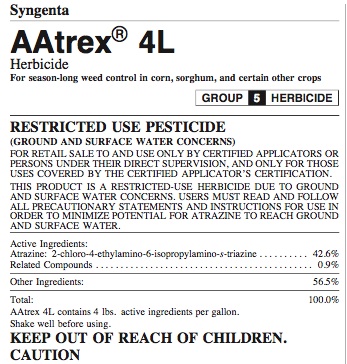 The New York Times' Charles Duhigg had reported in an August 2009 series called "Toxic Waters" on how huge spikes in atrazine concentration in drinking water were hidden from the American people and that scientists are concerned about atrazine's potential as an endocrine disruptor to affect hormone levels. The Natural Resources Defense Council had issued a major report documenting these issues. And Ivory had written about this online for HuffPo.
The New York Times' Charles Duhigg had reported in an August 2009 series called "Toxic Waters" on how huge spikes in atrazine concentration in drinking water were hidden from the American people and that scientists are concerned about atrazine's potential as an endocrine disruptor to affect hormone levels. The Natural Resources Defense Council had issued a major report documenting these issues. And Ivory had written about this online for HuffPo.
According to emails obtained by CMD, in March, Ivory was seeking comment on a number of questions about the coming federal lawsuit.
She wanted to know Syngenta's response to the allegation that the company, although it had the resources to do so, was refusing to aid communities seeking to remove atrazine from their water supplies. What was Syngenta's response to water utilities that could not afford the cost of removing the weed-killer from their customers' drinking water?
Ivory had previously reported that replacing the sand filtration system used by many water districts with carbon filters to remove atrazine were difficult for cash-strapped utilities to afford, especially after the Wall Street crash. She had noted that the conversion to carbon filtration could cost millions and that the carbon filters needed require annual replacement at a cost, for example, of over $100k for six filters.
Following several queries by Ivory, Minehart responded (PDF), via email on March 5, that atrazine was safe.
He also asserted, among other things, that since 2005 no water system in the nation had an "annual" average atrazine content above the three parts-per-billion ("3 ppb") threshold set by the EPA.
Less than an hour after Minehart's email had been sent, Ivory doggedly responded:
"Paul, thanks for this. I appreciate the statement, but I noticed that Syngenta did not respond directly to any of the questions that I asked...." She repeated her request for a comment on plaintiffs' claim they could not afford to filter Atrazine from their water supplies and that Syngenta should pay for it.
Ivory wasn't going to go away.
What to Do about a Persistent Reporter?
According to court records, Minehart then fired off a very interesting internal email, seeking guidance from others on Syngenta's team about how to further field Ivory's queries.
"Danielle is persistent: I just spoke with her. She said I did not respond to her questions!" the Minehart wrote.
The recipients of this email were Syngenta CP's director of communications, Sherry Ford, and three other Syngenta employees.
Also included on the email delivery chain were two public relations consultants: Josh Gilder, of White House Writers Group (WHWG), and Chris Robling, of Jayne Thompson and Associates (JTA), an Illinois public relations firm, hired as part of the company's PR strategy to deal with litigation in Illinois, among other things. WHWG had been part of Syngenta's PR team for about six months, coming on board after the New York Times story and NRDC report came out. (The litigation has opened a window on some of communications among the Syngenta PR team.)
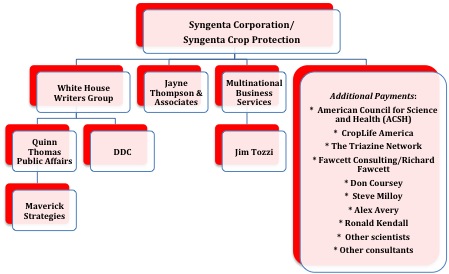 Before that day, March 5, Ivory had been on the radar screen of the Syngenta spin team, and someone decided to do more than just react to her stories.
Before that day, March 5, Ivory had been on the radar screen of the Syngenta spin team, and someone decided to do more than just react to her stories.
The day before, on March 4, Bret Jacobson, the founder and president of Maverick Strategies and Communications, a public relations/consulting firm specializing in "opposition research," submitted a dossier on Ivory to the firm "Quinn Thomas Public Affairs."
Quinn Thomas had been hired by Syngenta CP in October 2009, as part of an expanded PR operation led by WHWG, which the watchdog group Media Transparency has called "an umbrella firm of former ghostwriters for Republican presidents and bureaucrats now at the service of anyone willing to pay."
A "First-Strike" PR Team
Around the time of the New York Times investigation of atrazine levels and growing health concerns, according to e-mails discovered in the Holiday Shores suit, Syngenta CP had put out a request for proposals for a new PR effort.
According to the solicitation, Syngenta was seeking firms experienced with a "first strike" mentality and with managing "third party" spokespeople to carry Syngenta's message when it did not want those messages to be seen as coming from the corporation. It also listed (PDF) its top two primary audiences as "media" and "potential jurors." (The Holiday Shores case was pending in Illinois; the Jayne Thompson firm had been hired a few years earlier and would continue to be part of Syngenta's PR operation along with the new PR team being solicited.)
WHWG responded with a $498,000 base proposal that included funding for the "grassroots mobilization" firm DDC Advocacy, which has been described as a big player in the "astroturf" world of making corporate initiatives look like they are the result of wide and deep grassroots support.
A PR Team Known for Attacking Trial Lawyers
DDC reportedly has also co-chaired an astroturfing "roundtable" with the U.S. Chamber of Commerce, which is funded by the biggest global corporations in the world (WHWG has also spearheaded PR campaigns for the U.S. Chamber of Commerce). DDC has also worked on astroturf campaigns in the cyber-world against lawyers who represent injured Americans and in support of so-called "tort reform" that would limit the rights of Americans harmed or killed through corporate neglect or greed.
WHWG's proposal to Syngenta on atrazine also included Quinn Thomas Public Affairs, which was specifically touted for its success in "engaging" lawyers who represent American consumers and in fighting public interest groups through "aggressive third party activity." WHWG said Quinn Thomas' tactics had succesfully slowed or reversed "activist momentum."
"Third party activity" means using seemingly independent third parties that do not appear to be acting in concert with or at the behest of the corporation in a dispute. Aggressive, here, is undefined.
In documents uncovered through the Illinois state suit against Syngenta, a dossier on HuffPo reporter Danielle Ivory (PDF) has surfaced. Ivory had contacted Syngenta on March 2nd.
The March 4, 2010 dossier was prepared quickly by "Maverick Strategies" partner Bret Jacobsen as a memo to Quinn Thomas, who was working with WHWG, part of Syngenta CP's six-month old, expanded PR efforts.
From late 2009 through 2010, according to spreadsheets discovered in the litigation, WHWG's operations resulted in payments of over $1.2 million by Syngenta for "message management" and "campaign management." Its total to date is unknown.
Assessing a Reporter's "Motives"
As stated in the dossier, Quinn Thomas had sought an investigation into Ivory's history for "the purpose of assessing her motivations regarding her coverage of [a]trazine."
The dossier lists Ivory's work history as including a stint with Bill Moyers at the Schumann Center for Media and Democracy (which is distinct from the Madison-based Center for Media and Democracy), and a job at National Public Radio's award winning Weekend Edition. It also noted her writing for Democracy Now!, Alternet, Truthout, and HuffPo.
The dossier calls these respected organizations a "who's who of anti-employer employers."
Furthermore, wrote Jacobson, "[Ivory] has successfully used journalism to pressure an insurance company to reverse its decision not to cover a 12-year-old boy's prosthetic arm."
Aside from the purportedly unsavory nature of Ivory's past employers and her use of journalism to benefit a disabled child, he claimed the primary driver behind Ivory's atrazine reporting was egotism.
Noting that Democracy Now! host Amy Goodman had credited Ivory as the reporter who "broke the story on the EPA's [a]trazine cover-up," Jacobson concluded that Ivory's "professional reputation and ego are tied to the effectiveness of the attack on the chemical."
Democracy Now!: An "Anti-Employer Employer?"
Goodman had hosted Ivory to discuss her report, "EPA Fails to Inform Public about Weed Killer in Drinking Water." Ivory had examined data from the monitoring of 150 watersheds between 2003 and 2008. That data filed with the EPA was hidden from public eyes until demands for compliance with the Freedom of Information Act (FOIA) disgorged it.
The water testing data indicated that the Bush Administration's EPA had been aware of high atrazine levels in American's drinking water and had not disclosed that to the public.
 The Bush Administration had also entered into an agreement with Syngenta to test for atrazine in water supplies. Accordingly, Syngenta was aware that periodic spikes of atrazine concentration in water systems were occurring periodically throughout the nation. Dozens of these spikes were well over 3 ppb.
The Bush Administration had also entered into an agreement with Syngenta to test for atrazine in water supplies. Accordingly, Syngenta was aware that periodic spikes of atrazine concentration in water systems were occurring periodically throughout the nation. Dozens of these spikes were well over 3 ppb.
Documents revealed through litigation and compared with the public record show that Syngenta and its "third party" consultants and allies repeatedly told the public that atrazine levels were always in compliance with federal safety standard.
(The utilities in the federal suit, which are represented by the Korien Tillery law firm which also represents the water districts in the state class action, note that relying on annual averages obscures spikes in atrazine levels in community drinking water systems during the times of the year the weed-killer is applied to fields. One drinking water system in Indiana was measured to have a spike in atrazine level of 237.5 ppb, exponentially greater than 3 ppb, in a period in which the weed-killer was sprayed on cropland.)
Hiding the "Poisoning of the Well"
The Natural Resources Defense Council (NRDC) had examined data from the EPA's "Ecological Watershed Monitoring Program" and "Atrazine Monitoring Program," obtained via its FOIA litigation with the Bush Administration.
The results of this analysis were released by NRDC in August 2009 in a detailed report entitled, "Poisoning the Well: How the EPA Is Ignoring Atrazine Contamination in Surface and Drinking Water in the Central United States."
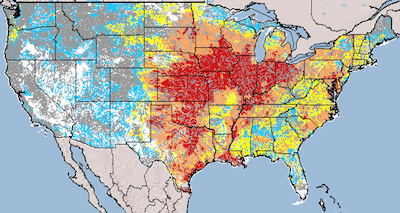 In it, Jennifer Sass, a senior scientist in NRDC's health and environment program, said "there is strong evidence that atrazine is an endocrine disrupting chemical interfering with critical reproductive hormones even at extremely low levels. This is because hormones in our bodies are active at very low levels, parts-per-billion or lower."
In it, Jennifer Sass, a senior scientist in NRDC's health and environment program, said "there is strong evidence that atrazine is an endocrine disrupting chemical interfering with critical reproductive hormones even at extremely low levels. This is because hormones in our bodies are active at very low levels, parts-per-billion or lower."
Jacobson, in the dossier on Ivory, noted that there were similarities between Ivory's findings and those of NRDC, although the data from different sources all showed spikes in atrazine levels in drinking water.
And, the dossier makes much of the fact that an NRDC blog congratulated Ivory on what it dubbed to be an "excellent investigative report" on the atrazine data.
Targeting the Tides Foundation
The dossier on Ivory also revealed that Maverick had given a dossier to Quinn Thomas on NRDC, the Pesticide Action Network of North America (PANNA), the Land Stewardship Project (LSP), and the Tides Foundation. That dossier was not in the documents unsealed by the court in the Holiday Shores litigation.
According to the Ivory dossier, Maverick had previously provided a more thorough report on these organizations than was summarized there. Its summary claimed that the listed environmental groups "share one very powerful, controversial funding source: The Tides Foundation, an uber-wealthy and far-left philanthropy...."
The March 4, 2010 dossier goes on to channel a Glenn Beck-like tone in linking the groups to Tides and its management in a guilt-by-association manner.
The dossier on Ivory notes that the Tides Center provided funding for a 1999 report on pesticides and herbicides, including atrazine. And, it notes that the Tides' donors gave NRDC between $64,000 and $96,000 a year for three years.
The amount of funding Maverick received from Quinn Thomas or the amount Quinn Thomas received from the Syngenta contract is not known; what is known is that WHWG received over one million dollar in fees for its work on the atrazine PR efforts.
Science Under Siege
NRDC and Syngenta have a long, contentious relationship.
 Due to an array of health concerns, NRDC has recommended that atrazine use be phased out and that the weed-killer be filtered out of Americans' contaminated drinking water. Its investigations and lawsuits in the public interest have resulted in judicial decrees requiring more monitoring of water and have spurred the EPA to subject the herbicide to additional reviews by the EPA Scientific Advisory Panel (SAP) -- including an EPA SAP atrazine review launched in October, 2009 -- based on emerging science and growing concerns.
Due to an array of health concerns, NRDC has recommended that atrazine use be phased out and that the weed-killer be filtered out of Americans' contaminated drinking water. Its investigations and lawsuits in the public interest have resulted in judicial decrees requiring more monitoring of water and have spurred the EPA to subject the herbicide to additional reviews by the EPA Scientific Advisory Panel (SAP) -- including an EPA SAP atrazine review launched in October, 2009 -- based on emerging science and growing concerns.
The dossier on Ivory also expressed the view that NRDC's "Poisoning the Well" report was in essence part of a conspiracy funded by Tides, which might include Ivory's work for HuffPo.
The dossier writer had also contacted HuffPo "to inquire about additional information about their funding model, sources and ties to the Tides family of organizations." Jacobson reported that he had not yet received a reply and that he did not expect further details.
As for Ivory, the dossier reported that its opposition research was based on "publicly" available information and was the best that could be prepared under the short deadline provided by Quinn Thomas.
On June 9, 2011, as part of a sworn deposition given in the Illinois suit, Syngenta's PR rep, Sherry Ford, denied that Syngenta or anyone acting on its behalf had "investigated" anyone except one person.
That person was not Danielle Ivory, according to Ford.
Yet, the March 4, 2010, dossier on Ivory was requisitioned by Syngenta's hired PR team following Ivory's query to Syngenta about the coming federal lawsuit. It was produced for a PR team known for its aggressive tactics. The term "investigated" was not specifically defined in the deposition or by the opposition research firm tapped by the PR team.
Syngenta Admits It Investigated Dr. Tyrone Hayes
No, the person Ford admitted had been investigated by Syngenta was not Ivory.
He's a U.C.-Berkeley scientist whose extensive studies suggest that atrazine causes sex mutations in frogs. (A detailed story of how Syngenta has attacked this scientist's reputation is reported in January's Mother Jones magazine. The deposition of Syngenta's head of PR is not discussed in that story.)
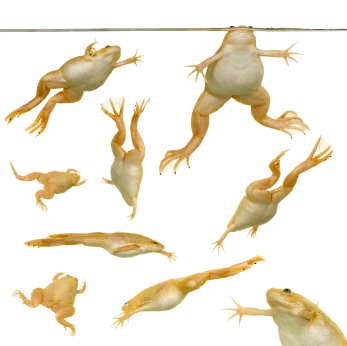 Ford claimed under oath that she herself no longer has the opposition research on Dr. Hayes.
Ford claimed under oath that she herself no longer has the opposition research on Dr. Hayes.
She also claimed under oath that Syngenta's expanded first-strike PR team had been assembled in late 2009 in direct response to a tip they had received from a reporter indicating that a new federal lawsuit against the company was in the offing. At the time of Ivory's e-mail exchange with Syngenta's Paul Minehart starting March 2, 2010, the company claimed it had no knowledge of any pending federal litigation or of the allegations of the plaintiffs about atrazine.
On March 5th, HuffPo ran a story about atrazine contamination in Iowa, but it was not by Ivory.
The piece by Kerry Trueman, titled "Our Toxic Waterways: Flushing Away Our Future," discussed a new documentary called "Big River," by Ian Cheney and Kurt Ellis whose previous piece "King Corn," won critical acclaim. The new documentary traced how the atrazine they used to grow corn had contaminated their local creek.
Trueman noted that recent news stories had reported concerns that atrazine might chemically castrate or "feminize" male frogs, according to Dr. Hayes' research, and that the EPA had recently announced it would re-assess the weed-killer.
Searching for a Defender of Atrazine on HuffPo
In response, Syngenta CP's Steven Goldsmith sent an email to Josh Gilder of WHWG and Mike Burita at Quinn Thomas asking an interesting question (PDF).
"Is there anyone at HP [HuffPo] who we could cultivate on this issue rather than continuing to get bashed by everyone on their payroll?"
WHWG and Quinn Thomas had already been hard at work for six months on an array of tactics to advance Syngenta PR's third party strategy on atrazine.
One was to have Syngenta's chief scientist, Dr. Mike Bushell, ghostwrite a chapter for a book challenging the idea of regulating atrazine by applying the "precautionary principle."
This standard, which is embedded in U.S. and EU consumer law, places the burden of proof on manufacturers to establish that their products are not harmful if science points to significant risks to human health or the environment. WHWG said (PDF) it would "find someone else willing to put their name" on Syngenta's "Ghost Author" story about atrazine and challenge the potential embrace of the precautionary principle by the Obama Administration's EPA.
The ghostwritten chapter was for a book to be published in conjunction with someone at the American Enterprise Institute, a DC think tank that is funded in part by large donations from corporations. It is not known whether Syngenta has funded this think tank or any of its "fellows," directly or indirectly.
Also Needed: An Investigative Reporter to Rattle the EPA's Cages
On December 3, 2009, Syngenta's in-house PR staff held a planning meeting to deal with the fallout from the New York Times investigation, the agenda (PDF) was to "[o]btain the services of a well know (sic) investigative reporter to probe around the EPA" and, at a minimum get advice "on what buttons to push and cages to rattle."
As part of the effort to influence EPA's review, another tactic was to identify long-term needs for published materials and which third parties "should be approached/retained."
Unsealed e-mails reveal (PDF) that earlier that same week WHWG had reported to Syngenta that a third party the PR team was in communication with was Jon Entine of the American Enterprise Institute. Entine is a former producer with NBC and ABC News, whose books attacked the idea of socially responsible investing and the precautionary principle (Let Them Eat Precaution).
The "Third Party" Technique in Action
While WHWG worked to cultivate new third party voices for Syngenta, some old mainstays of the company continued to defend it in the press.
For example, Elizabeth Whelan had long been on the short-list of people Syngenta's PR team considered when shopping corporate op-eds to publish under someone else's byline.
Whelan is the president of the "American Council for Science and Health" (ACSH). ACSH has been called "a receptacle for payments from pharmaceutical, chemical, biotechnology, food and other companies who appreciate the convenience of having their grantees and former employees serve on government science panels," by Michael Jacobsen, the Director of the Center for Science in the Public Interest.
Jacobsen told the Washington Times that ACSH had "stopped disclosing its donors in the 1990s, presumably out of embarrassment." ACSH's list of leaders, scientists, and co-collaborators include other names of third party advocates that pop up in the e-mails unsealed in the litigation.
ACSH had already been enlisted (PDF) by the Syngenta PR team to attack the New York Times article by Charles Duhigg, "Debating How Much Weed Killer Is Safe in Your Water Glass," before the story was even published on August 22, 2009, and she responded right away.
ACSH's Beth Whelan Defends Atrazine, Without Disclosing Big Bucks
Whelan defended atrazine in a morning appearance on MSNBC the week the story broke. She told viewers across America that the New York Times story was "bogus."
She did not tell viewers that she was the beneficiary of big donations from Syngenta.
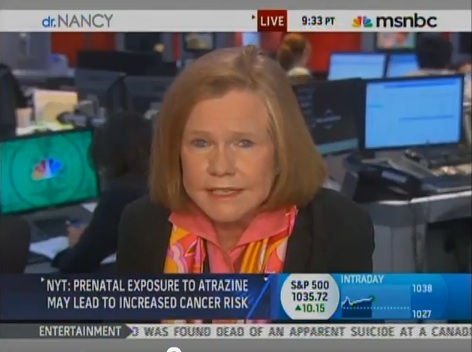 In the MSNBC debate with Whelan, the NRDC's Jennifer Sass suggested that scientific studies indicated that atrazine had chemically castrated frogs, by disrupting their endocrine systems with even small amounts of the weed-killer, which Whelan dismissed.
In the MSNBC debate with Whelan, the NRDC's Jennifer Sass suggested that scientific studies indicated that atrazine had chemically castrated frogs, by disrupting their endocrine systems with even small amounts of the weed-killer, which Whelan dismissed.
When Duhigg's New York Times article was reprised on NPR's "Fresh Air" in late October 2009, Whelan and her colleague at ACSH, Gilbert Ross, reached (PDF) out to Syngenta's (PDF) PR team again with their spin on atrazine, claiming:
"Mr. Duhigg's articles are replete (PDF) with exaggerated risk, bias, misrepresented science and sensationalism.... 'Chemophobia' is in: scaring people about chemicals in our food, water and consumer products gets attention -- but it is counterproductive, distracting us from the real public health hazards we face today."
In an October 20, 2009 email (PDF) from WHWG's Josh Gilder sent a note to his colleagues on the Syngenta PR team with a framework for countering the Duhigg analysis:
"I believe Duhigg's interview on NPR represents the new line of attack on [a]trazine, and just as the other side has been getting its organizational duck in a row, they have advanced their message in a way that will require a certain amount of catching up on our part," wrote Gilder. "This advanced message is that 'new science' suggests that exposure to even infinitesimal amounts of atz, measured in ppb, at critical points in pregnancy can cause birth defects or premature birth for a few members of the population. This renders past EPA decisions less compelling, as this is 'new science.'"
WHWG recommended Syngenta enlist the aid again of allies at ACSH -- namely Ross and Whelan.
ACSH Gets "Lifeblood" Funding from "Dear Syngenta Friends"
As the e-mails uncovered in the litigation reveal, Whelan had also submitted a new financial proposal from ACSH for a special project from Syngenta. The proposal began "Dear Syngenta friends" and proposed that ACSH produce a publication on pesticide and Atrazine exposure and human health.
She was seeking $100,000 to publish and consumerize a discussion of "myths and realities" about agribusiness chemicals and health.
Her proposal concluded by noting that her request was separate from the "general operating support Syngenta has been so generously providing over the years, which we request to continue at current or increased levels. Such general operating support is the lifeblood of a small non-profit like ours, and is both deeply appreciated and much needed."
Whelan, the president of the non-profit ACSH, is paid over $350,000 a year out of the organization's $2 million in annual income, as of 2009. It is not clear how much "lifeblood" Syngenta pays each year as its generous contribution to ACSH budget and Whelan's large salary.
ACSH's published materials include a boilerplate disclaimer that it accepts grants from any source but that it is solely responsible for its research and that it "does not accept support from individual corporations for specific research projects."
Spinning the Idea of "Chemophobia"
While aiding in attacks on Duhigg's New York Times reporting, Whelan pushed the idea that people expressing concerns were engaged in "chemophobia," an irrational fear of chemicals.
The e-mails contained in the court record are incomplete regarding ACSH's project grant proposal, the total funding it has received over the years, and the subsequent funding for ACSH, WHWG, and others post-spring 2010.
Nevertheless, it is plain that Syngenta's PR operations did not suddenly cease that spring, with the EPA's decision on atrazine still pending along with ongoing litigation in the state and federal courts.
And just last month a long-time friend of Syngenta announced the release of a new book.
It was finalized in 2011 along with a "companion friendly" paper called "Scared to Death: How Chemophobia Threatens Public Health." The book attacks the EPA and "harmful, unnecessary regulation" as well as the precautionary principle.
It has a chapter-long "case study" defending atrazine, just as members of the Syngenta PR team had been seeking.
The publisher? ACSH, consistent with the pitch Whelan made to Syngenta.
The book? Designed to rattle the cages at the EPA, which was on the Syngenta PR team's wishlist.
The author? John Entine, described as a highly regarded science reporter from the American Enterprise Institute, a third party Syngenta's PR team had been cultivating.
The HuffPo contributor who wrote about the book and its attack on critics of atrazine? It was Entine, whom Syngenta trusted.
It was not the investigated investigative HuffPo reporter, Danielle Ivory.
About the Authors: Beau Hodai has worked with In These Times as a Staff Writer and is the founder of DBApress.com. He is a guest author for the Center for Media and Democracy (CMD). Lisa Graves is CMD's Executive Director and Editor-in-Chief. Previously, Graves was the Chief Counsel for Nominations for the U.S. Senate Judiciary Committee and Deputy Assistant Attorney General in the U.S. Department of Justice, among other posts.
About this Project: Documents obtained by CMD, recently unsealed as part of a major lawsuit against Syngenta, reveal how the global chemical company's PR team investigated the press and spent millions to spin news coverage and public perceptions in the face of growing concerns about potential health risks from the widely used weed-killer atrazine. This story is part one of a series about Syngenta's PR campaign to influence the media, potential jurors, potential plaintiffs, farmers, politicians, scientists, and the EPA in the midst of reviews of the weed-killer's potential to act as an endocrine disruptor and concerns about the persistence of the chemical and its metabolytes in drinking water.
For More Information: The U.S. Geological Survey is one resource for citizens to look at the levels of atrazine in water. Click here for an interactive map. To see a list of products containing atrazine, click here. To see the documents released as part of this investigative series, click here.


Comments
Anonymous replied on Permalink
Well done guys, you've
Anonymous replied on Permalink
Well Done
Anonymous replied on Permalink
Very well done
Anonymous replied on Permalink
Very well done
anonymous replied on Permalink
Good Point About Morals
Mutternich replied on Permalink
...but not sure what the
Kate DeBraose replied on Permalink
poisoned public water supplies
Anonymous replied on Permalink
This is hilarious
Mutternich replied on Permalink
I get it now.
Anonymous replied on Permalink
The PR Guy's List is Incomplete ...
Pages